Sustainable Preservation of Historical Temples Through Ventilation Airflow Dynamics and Environmental Analysis Using Computational Fluid Dynamics
Abstract
1. Introduction
2. Historic Building Geometry for Simulation
3. Methodology and Mathematical Formulations
3.1. Onsite Measurement for Realistic Boundary Conditions
3.2. Computational Boundary Condition
3.3. Airflow Physics and Turbulence Modeling
3.3.1. Transport Equations for Shear Stress Transport Turbulence Model
3.3.2. Species Transport Equations
3.3.3. Thermal Diffusion Coefficient
3.3.4. Turbulence Boundary Conditions
3.3.5. Environment of Wind Direction Methodology
3.3.6. Solution Initialization for Flow Analysis
4. Solution Methodology
4.1. Grid Generation
4.2. Grid Independence Analysis
4.3. Numerical Setting
4.4. Validation Study
4.4.1. Academic Test Case
4.4.2. Onsite Validation Test Case
5. Results
5.1. Flow Behavior and Recirculation Analysis of the Na Phra Meru Historical Temple
5.2. Air Property Distribution in the Temple
5.3. Fluctuation in Environmental Behavior in Temple
5.4. Effect of Small Slits on Ordination Hall Air Ventilation
5.5. Correlation of Aerodynamic Properties and Flow Characteristics
- Velocity and Temperature: For all directions, there was a negative correlation between air velocity and temperature. The strongest negative correlation was for the northeast wind condition (NE = −0.55), indicating that higher air velocities were associated with lower temperatures.
- Velocity and TKE: Correlation values between velocity and TKE were in the range −0.061 to 0.51. Depending on direction, this relationship was generally weak-to-moderate, with a strong positive response under north wind conditions (N = 0.51), indicating that a stronger airflow increased turbulence, especially from the north.
- Velocity and Relative Humidity: There was a positive correlation between velocity and RH for all studied directions, ranging from 0.21 to 0.54. The strongest positive association was in the northeast wind direction (NE = 0.54), suggesting that a higher airflow can increased humidity mixing, potentially reducing localized moisture buildup.
- Temperature and TKE: These correlations were generally weak and inconsistent, ranging from 0.002 to −0.64. The strongest inverse relationship was for north wind conditions (N = −0.64), suggesting that high turbulence may contribute to temperature reduction.
- Temperature and RH: This relationship was strongly negative and remarkably consistent for all wind directions, with a value of −1.00 in each case. This suggested a perfectly inverse relationship—as the temperature increased, the relative humidity decreased—a well-established physical principle, confirming the reliability of the data.
- TKE and RH: The relationship between TKE and RH was weak and varied with wind direction, ranging from −0.24 to 0.64. There was a moderate positive correlation for the north wind condition, indicating that increased turbulence may support humidity distribution in some cases, though the relationship was inconsistent across all scenarios.
5.6. Aerodynamic Forces and Risk of Building Damage
5.7. Aerodynamic Moment and Structural Stability Risk
6. Conclusions
- Internal airflow patterns were highly sensitive to wind direction, with distinct recirculation zones forming when the incoming wind was not aligned with the main entrance. This airflow behavior directly influenced temperature and humidity stability within the Temple, affecting the long-term preservation of materials.
- In the analysis of the distribution of airflow properties, the spatial mapping of temperature, relative humidity, and turbulence kinetic energy (TKE) revealed that the central interior zone maintained relatively stable environmental conditions. However, there was increased moisture accumulation near wall surfaces, particularly in areas with low TKE. These conditions could encourage fungal growth and surface deterioration, consistent with observed physical damage on the rear wall of the Buddha image area.
- The assessment of airflow fluctuation using the UI provided further insight into microclimatic consistency. Temperature and humidity values were highly uniform, with UI values above 0.95. However, there was greater variability in velocity and TKE, especially in areas affected by recirculation zones. These fluctuations contributed to uneven heat and moisture distribution, possibly accelerating structural aging and material wear.
- One of the study’s most notable findings was the identification of the role of the slit windows in natural ventilation. Contrary to prior assumptions, the airflow through these small architectural features did not merely escape but also formed a self-regulating outward air layer. This layer acted as a barrier that prevented external air from re-entering the building, helping to stabilize the indoor environment. This newly identified aerodynamic function has provided a deeper understanding of traditional Thai temple ventilation strategies.
- Correlation analysis further confirmed the relationships among key environmental variables. There was a strong negative correlation between temperature and humidity and moderate correlations between velocity, TKE, and humidity. These quantitative relationships should provide a scientific foundation for developing improved microclimate management strategies in heritage buildings.
- The analysis of aerodynamic forces revealed that wind direction had a marked impact on the magnitude and spatial distribution of force across the structure. The E and NE wind directions generated the highest loads, posing structural risks due to intense lateral pressure and potential uplift.
- Finally, the moment analysis identified critical rotational stresses acting on the Temple. The E wind produced the largest rotational moment across the building width, while the NE wind was responsible for dominant moments in the length and vertical directions. These rotational effects highlighted the need to reinforce vulnerable structural components, including roof joints, ridge beams, wall corners, and projecting eaves, to reduce the risk of wind-induced fatigue.
Author Contributions
Funding
Institutional Review Board Statement
Informed Consent Statement
Data Availability Statement
Acknowledgments
Conflicts of Interest
References
- World Heritage Centre. Climate Change and World Heritage. Available online: https://whc.unesco.org/en/climatechange/ (accessed on 9 June 2024).
- Diodato, N.; Ljungqvist, F.C.; Bellocchi, G. Historical predictability of rainfall erosivity: A reconstruction for monitoring extremes over Northern Italy (1500–2019). Npj Clim. Atmos. Sci. 2020, 3, 46. [Google Scholar] [CrossRef]
- Guo, Q.; Huang, J.; Pei, Q.; Zhang, B.; Zhan, H.; Zhang, H.; Richards, J.; Viles, H. Erosion Model for Wind-Blown Sand Flow at Earthen Sites in Arid Environment, Northwest China. Int. J. Archit. Herit. 2023, 19, 96–113. [Google Scholar] [CrossRef]
- Mannini, C.; Massai, T.; Panettieri, E.; Barni, N.; Giachetti, A.; Ferrucci, M.; Montemurro, M.; Vannucci, P. Experimental Study of the Wind Pressure Field on the Notre Dame Cathedral in Paris. Int. J. Archit. Herit. 2024, 18, 194–214. [Google Scholar] [CrossRef]
- Halder, S.; Parekh, A.; Chowdary, J.S.; Gnanaseelan, C. Dynamical and moist thermodynamical processes associated with Western Ghats rainfall decadal variability. Npj Clim. Atmos. Sci. 2022, 5, 8. [Google Scholar] [CrossRef]
- Metals, M.; Lesinskis, A.; Borodinecs, A.; Turauskis, K. Preliminary Study on Indoor Air Temperature and Moisture Behaviour in 13th-Century Churches in Latvia. Sustainability 2023, 15, 13965. [Google Scholar] [CrossRef]
- Liu, D.; Cao, K.; Tang, Y.; Zhang, J.; Meng, X.; Ao, T.; Zhang, H. Study on weathering corrosion characteristics of red sandstone of ancient buildings under the perspective of non-destructive testing. J. Build. Eng. 2024, 85, 108520. [Google Scholar] [CrossRef]
- Esteban-Cantillo, O.J.; Menendez, B.; Quesada, B. Climate change and air pollution impacts on cultural heritage building materials in Europe and Mexico. Sci. Total Environ. 2024, 921, 170945. [Google Scholar] [CrossRef]
- Zhao, B.; Han, W. Research on Measuring Methods and Influencing Factors of Spatial Damage Degree of Historic Sites: A Case Study of Three Ancient Cities in Shanxi, China. Buildings 2023, 13, 2957. [Google Scholar] [CrossRef]
- Rizou, M.E.; Marcelli, R.; Capoccia, G.; Proietti, E. Non-destructive microwave techniques for the quantification and elimination of moisture in cultural heritage monuments. J. Cult. Herit. 2024, 67, 270–276. [Google Scholar] [CrossRef]
- Sánchez Espinosa, K.C.; Rodríguez Davydenko, S.; Rojas Flores, T.I.; Fernández-González, M.; Almaguer, M. Xerophilic and cellulolytic fungi in the indoor air of houses in Havana. Int. Biodeterior. Biodegrad. 2024, 188, 105730. [Google Scholar] [CrossRef]
- Dyda, M.; Pyzik, A.; Wilkojc, E.; Kwiatkowska-Kopka, B.; Sklodowska, A. Bacterial and fungal diversity inside the medieval building constructed with sandstone plates and lime mortar as an example of the microbial colonization of a nutrient-limited extreme environment (Wawel royal castle, Krakow, Poland). Microorganisms 2019, 7, 416. [Google Scholar] [CrossRef]
- Kakakhel, M.A.; Wu, F.; Gu, J.D.; Feng, H.; Shah, K.; Wang, W. Controlling biodeterioration of cultural heritage objects with biocides: A review. Int. Biodeterior. Biodegrad. 2019, 143, 104721. [Google Scholar] [CrossRef]
- Chaudhuri, A.; Bhattacharyya, S.; Chakraborty, A.; Mukherjee, S.; Sudarshan, M.; Ghosh, C.K.; Chaudhuri, P. Inhibitory effect of UV and gamma radiation for fungal biodeterioration of concrete: A short-term study for sustainable conservation. J. Cult. Herit. 2024, 66, 316–325. [Google Scholar] [CrossRef]
- Martin-Pozas, T.; Fernandez-Cortes, A.; Cuezva, S.; Jurado, V.; Gonzalez-Pimentel, J.L.; Hermosin, B.; Ontañon, R.; Arias, P.; Cañaveras, J.C.; Sanchez-Moral, S.; et al. Microclimate, airborne particles, and microbiological monitoring protocol for conservation of rock-art caves: The case of the world-heritage site La Garma cave (Spain). J. Environ. Manag. 2024, 351, 119762. [Google Scholar] [CrossRef]
- Matoušková, E.; Kovářová, K.; Cihla, M.; Hodač, J. Monitoring biological degradation of historical stone using hyperspectral imaging. Eur. J. Remote Sens. 2024, 57, 2220565. [Google Scholar] [CrossRef]
- Chen, G.; Rong, L.; Zhang, G. Unsteady-state CFD simulations on the impacts of urban geometry on outdoor thermal comfort within idealized building arrays. Sustain. Cities Soc. 2021, 74, 103187. [Google Scholar] [CrossRef]
- Ascione, F.; De Rossi, F.; Iovane, T.; Mastellone, M. Microclimatic control of a fourteenth-century Church in Italy: The design of systems by experiments and simulations. Energy Build. 2023, 293, 113199. [Google Scholar] [CrossRef]
- Athira, K.S.; Roxy, M.K.; Dasgupta, P.; Saranya, J.S.; Singh, V.K.; Attada, R. Regional and temporal variability of Indian summer monsoon rainfall in relation to El Niño southern oscillation. Sci. Rep. 2023, 13, 12643. [Google Scholar] [CrossRef]
- Li, J.; Zhang, H.; Fan, Z.; He, X.; He, S.; Sun, M.; Ma, Y.; Fang, S.; Zhang, H.; Zhang, B. Investigation of the renewed diseases on murals at Mogao Grottoes. Herit. Sci. 2013, 1, 31. [Google Scholar] [CrossRef]
- Cheng, J.C.P.; Zhang, J.; Kwok, H.H.L.; Tong, J.C.K. Thermal performance improvement for residential heritage building preservation based on digital twins. J. Build. Eng. 2024, 82, 108283. [Google Scholar] [CrossRef]
- Qian, Y.; Leng, J.; Zhou, K.; Liu, Y. How to measure and control indoor air quality based on intelligent digital twin platforms: A case study in China. Build. Environ. 2024, 253, 111349. [Google Scholar] [CrossRef]
- Iskandar, L.; Bay-Sahin, E.; Martinez-Molina, A.; Toker Beeson, S. Evaluation of passive cooling through natural ventilation strategies in historic residential buildings using CFD simulations. Energy Build. 2024, 308, 114005. [Google Scholar] [CrossRef]
- Liu, J.; Azhar, S.; Willkens, D.; Li, B. Static Terrestrial Laser Scanning (TLS) for Heritage Building Information Modeling (HBIM): A Systematic Review. Virtual Worlds 2023, 2, 90–114. [Google Scholar] [CrossRef]
- Wang, W.; Hei, M.; Peng, F.; Li, J.; Chen, S.; Huang, Y.; Feng, Z. Development of “air-ground data fusion” based LiDAR method: Towards sustainable preservation and utilization of multiple-scaled historical blocks and buildings. Sustain. Cities Soc. 2023, 91, 104414. [Google Scholar] [CrossRef]
- Krishna, Z.; Gandhar, P.; Balasubramanyam Varghese, A.; ANSYS Inc.; Zore, K.; Sasanapuri, B.; Parkhi, G.; Varghese, A. Ansys mosaic poly-hexcore mesh for high-lift aircraft configuration. In Proceedings of the 21st Annual CFD Symposium, Bangalore, India, 1–11 September 2019. [Google Scholar]
- Sudirman, M.; van Hooff, T.; Gillmeier, S.; Blocken, B. Validation study of cross-ventilation in a realistic building geometry: RANS, SAS and LES. Build. Environ. 2025, 269, 112354. [Google Scholar] [CrossRef]
- Chen, F.; Yu, S.C.M.; Lai, A.C.K. Modeling particle distribution and deposition in indoor environments with a new drift-flux model. Atmos. Environ. 2006, 40, 357–367. [Google Scholar] [CrossRef]
- Caselli, E.; Pancaldi, S.; Baldisserotto, C.; Petrucci, F.; Impallaria, A.; Volpe, L.; D’Accolti, M.; Soffritti, I.; Coccagna, M.; Sassu, G.; et al. Characterization of biodegradation in a 17th century easel painting and potential for a biological approach. PLoS ONE 2018, 13, e0207630. [Google Scholar] [CrossRef]
- Vieto, S.; Escudero-Leyva, E.; Avendaño, R.; Rechnitzer, N.; Barrantes-Madrigal, M.D.; Conejo-Barboza, G.; Herrera-Sancho, O.A.; Chaverri, P.; Chavarría, M. Biodeterioration and cellulolytic activity by fungi isolated from a nineteenth-century painting at the National Theatre of Costa Rica. Fungal Biol. 2022, 126, 101–112. [Google Scholar] [CrossRef]
- Ma, W.; Wu, F.; He, D.; Li, J.; Zhang, Q.; Yang, X.; Gu, J.D.; Wang, W.; Feng, H. The biodeterioration outbreak in Dunhuang Mogao Grottoes analyzed for the microbial communities and the occurrence time by C-14 dating. Int. Biodeterior. Biodegrad. 2023, 178, 105533. [Google Scholar] [CrossRef]
- Menke, R.; Vasiljevi, N.; Mann, J.; Lundquist, J.K. Characterization of flow recirculation zones at the Perdigão site using multi-lidar measurements. Atmos. Chem. Phys. 2019, 19, 2713–2723. [Google Scholar] [CrossRef]
- Liu, J.; Wu, F.; Xiang, T.; Ma, W.; He, D.; Zhang, Q.; Wang, W.; Duan, Y.; Tian, T.; Feng, H. Differences of airborne and mural microorganisms in a 1500-year-old Xu Xianxiu’s Tomb, Taiyuan, China. Front. Microbiol. 2023, 14, 1253461. [Google Scholar] [CrossRef]
- Yang, G.; Yang, X.; Li, C.; Wei, X.; Lu, Z.; Zhang, C.; Wang, Q.; Wu, X. Numerical study on the uniform distribution of flow field of airflow dryer. Heliyon 2024, 10, e29439. [Google Scholar] [CrossRef] [PubMed]
- ANSYS Inc. ANSYS Fluent Theory Guide Turbulence Model; Ansys Inc.: Canonsburg, PA, USA, 2024. [Google Scholar]
- Newport Partners, LLC. Building Moisture and Durability Past, Present and Future Work. 2004. Available online: https://www.huduser.gov/publications/pdf/buildingmoistureanddurability.pdf (accessed on 14 May 2025).
- Hu, J.; Wang, Y.; Wang, D.; Du, H.; Fan, J.; Liu, Y.; Sun, X. Indices for dynamic evaluation of indoor humidity and thermal environment. Commun. Eng. 2023, 2, 59. [Google Scholar] [CrossRef]
- Chen, H.; Zhu, S.; Ye, T.; Miao, Y. Optimizing Urban Ventilation in Heritage Settings: A Computational Fluid Dynamics and Field Study in Zhao’an Old Town, Fujian. Buildings 2025, 15, 483. [Google Scholar] [CrossRef]
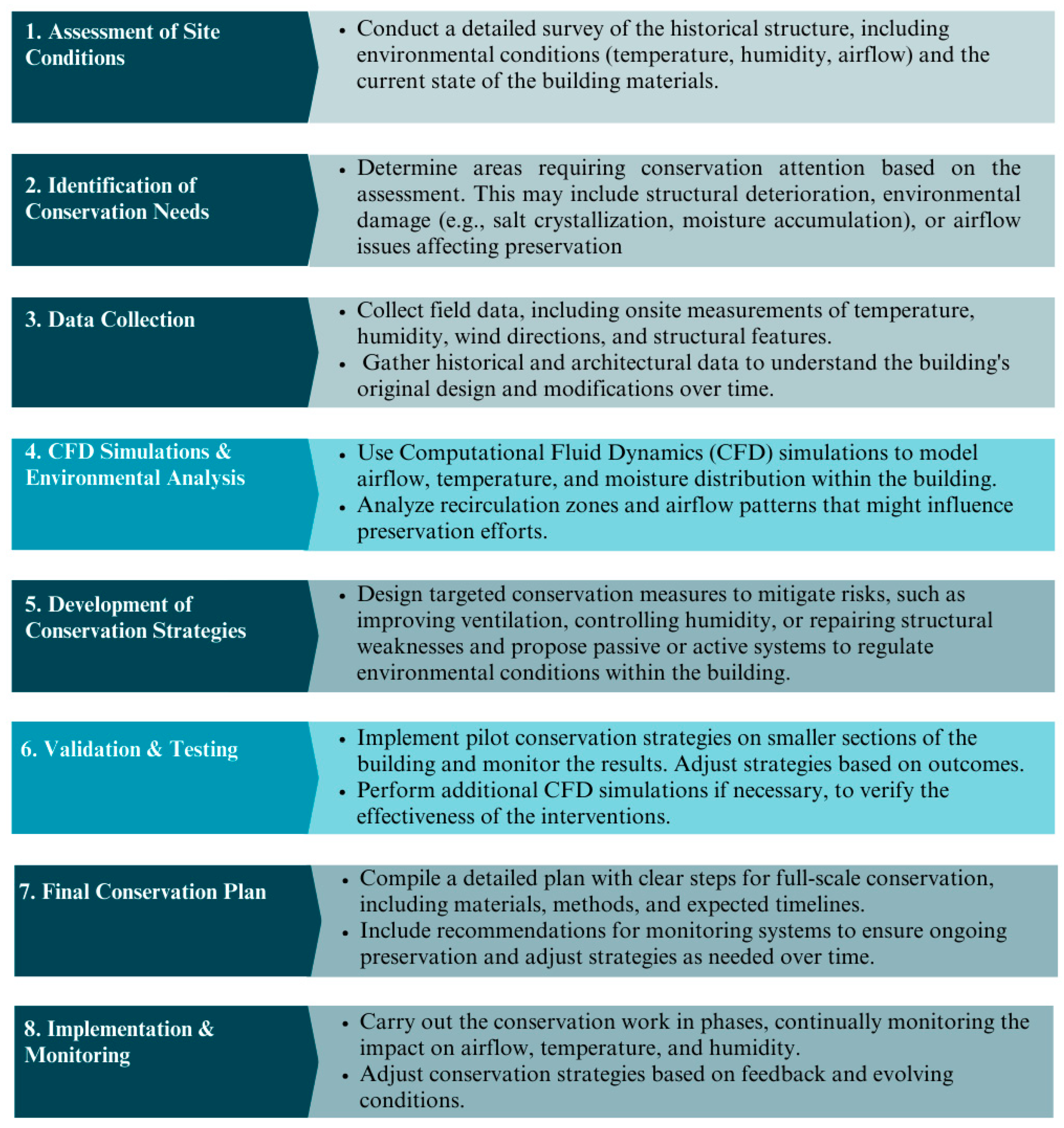
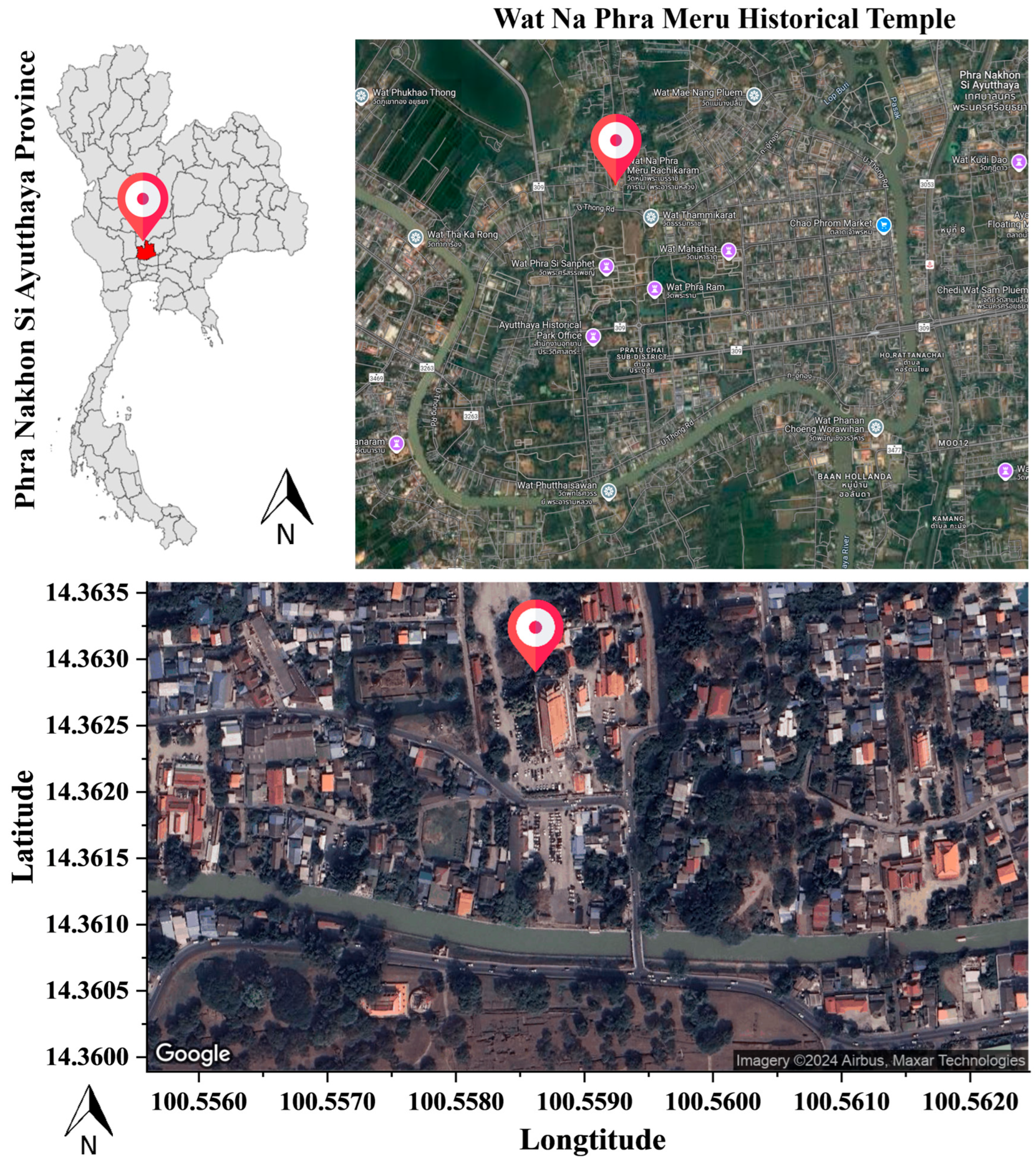
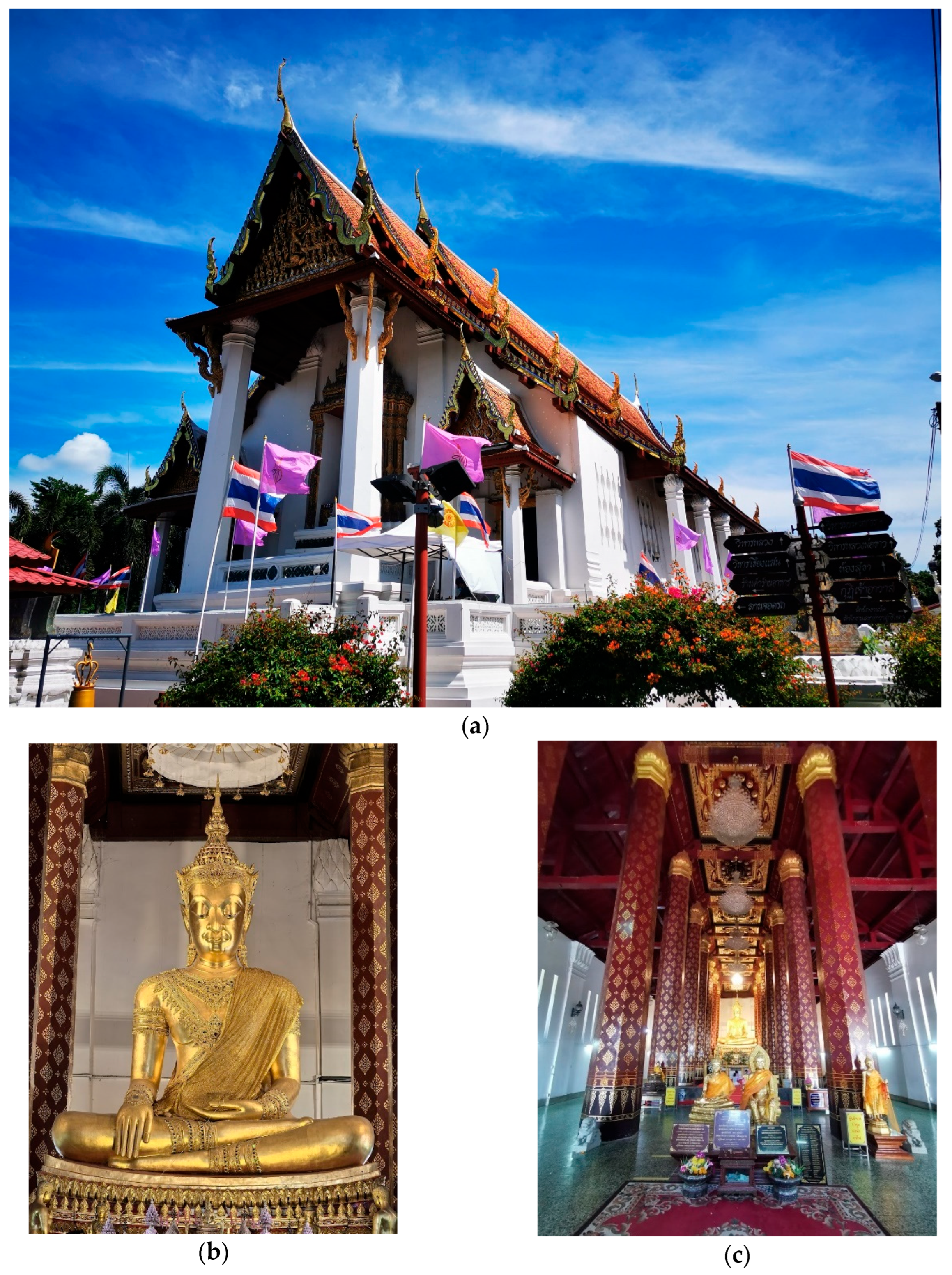
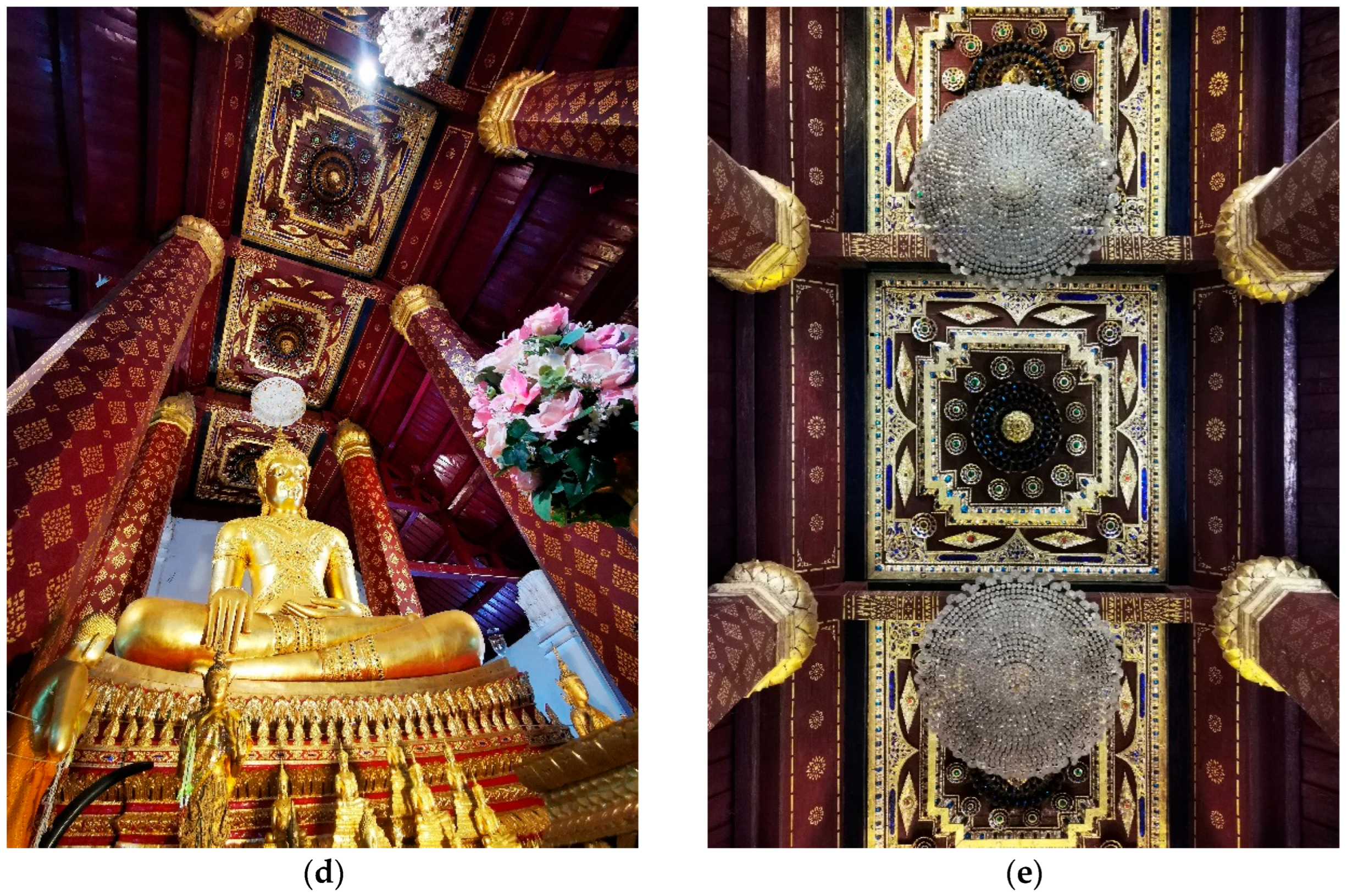

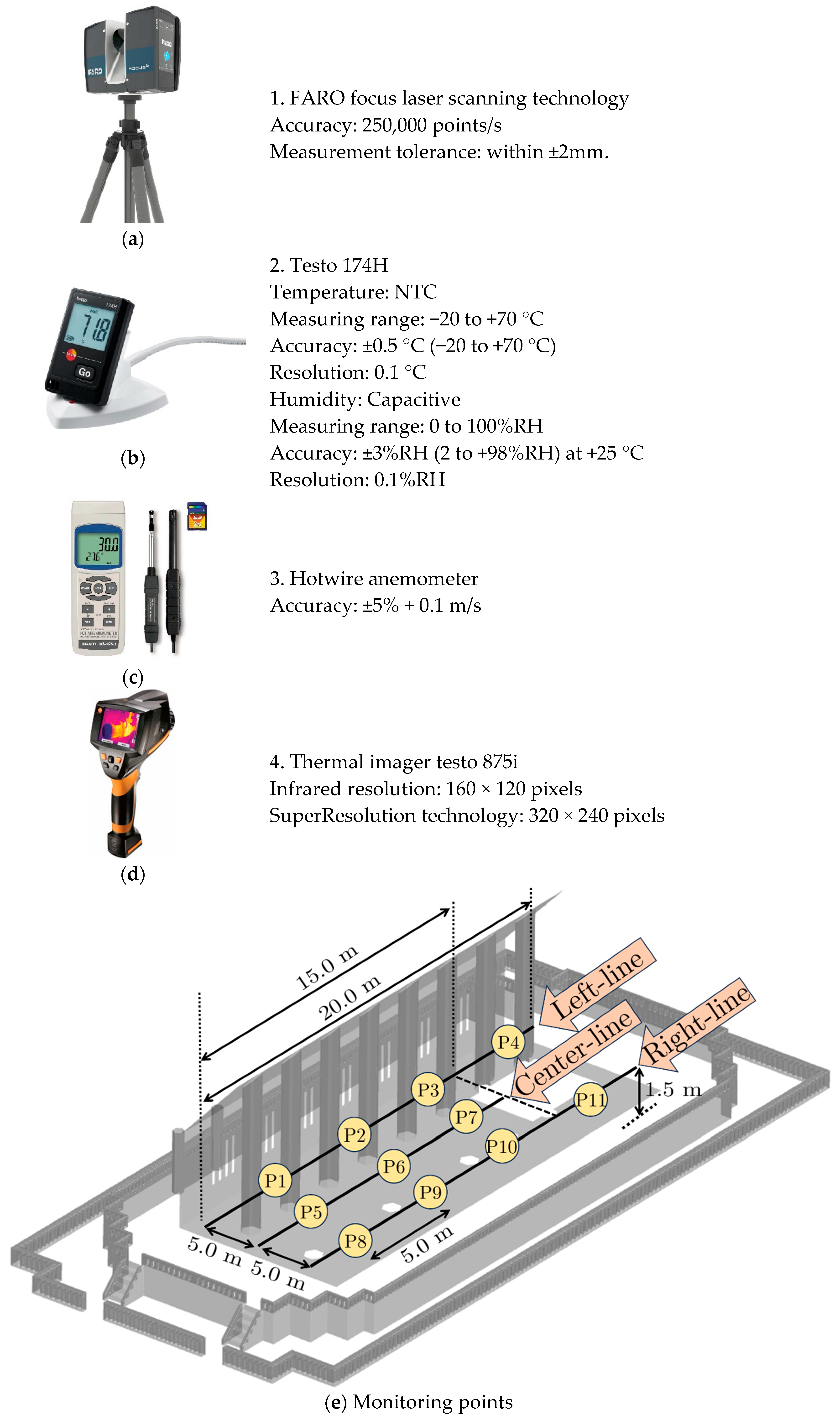
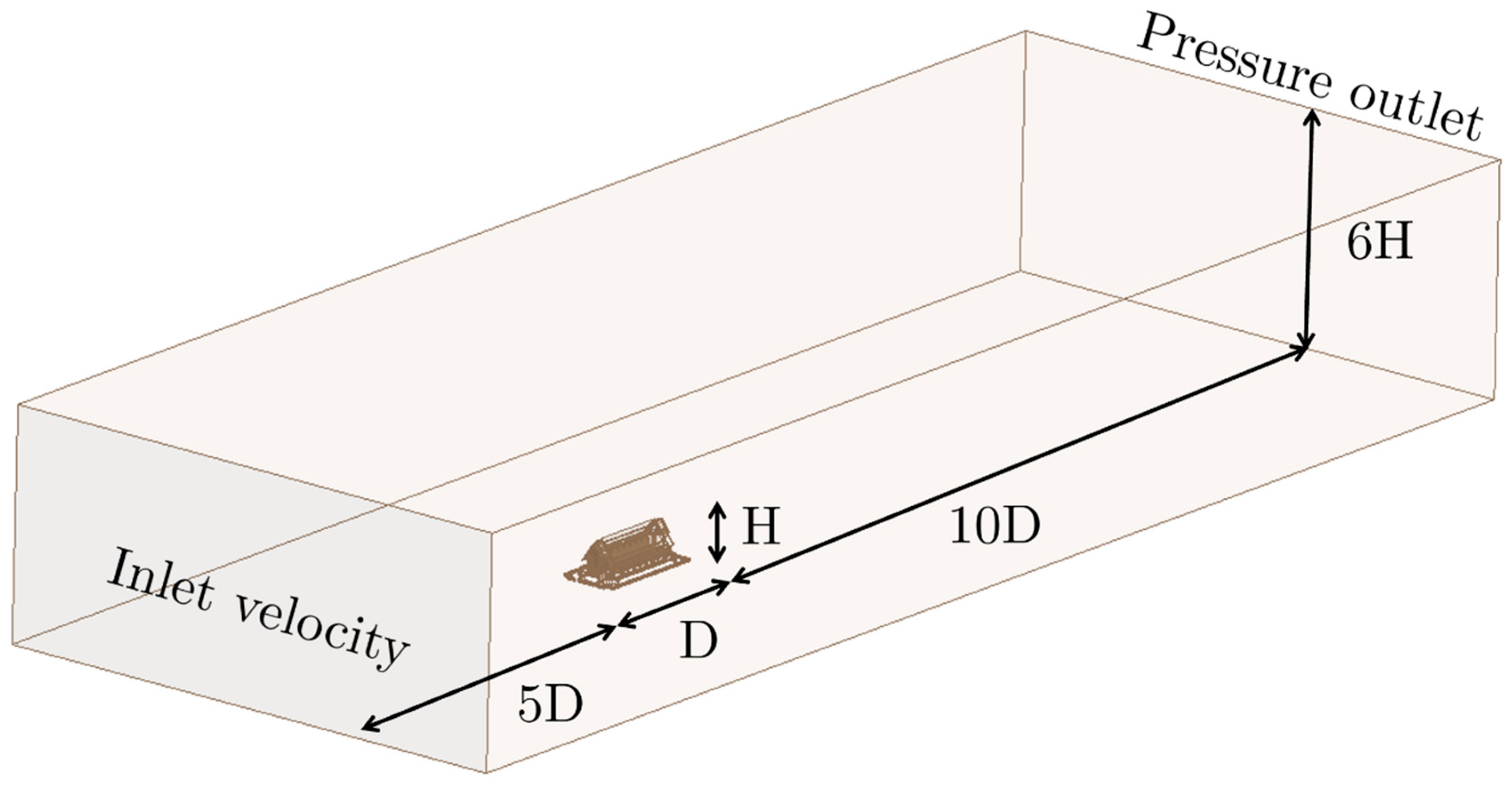

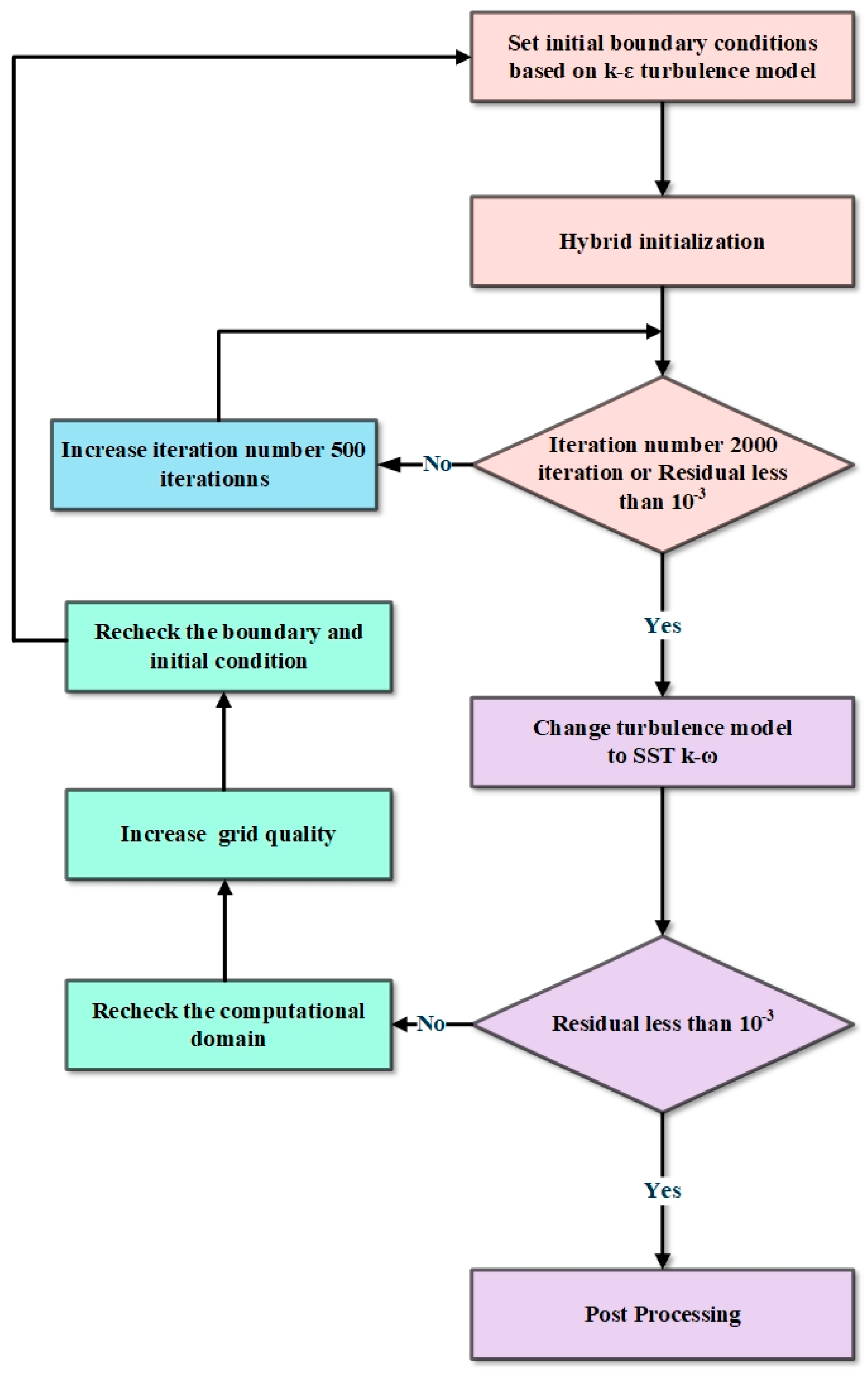
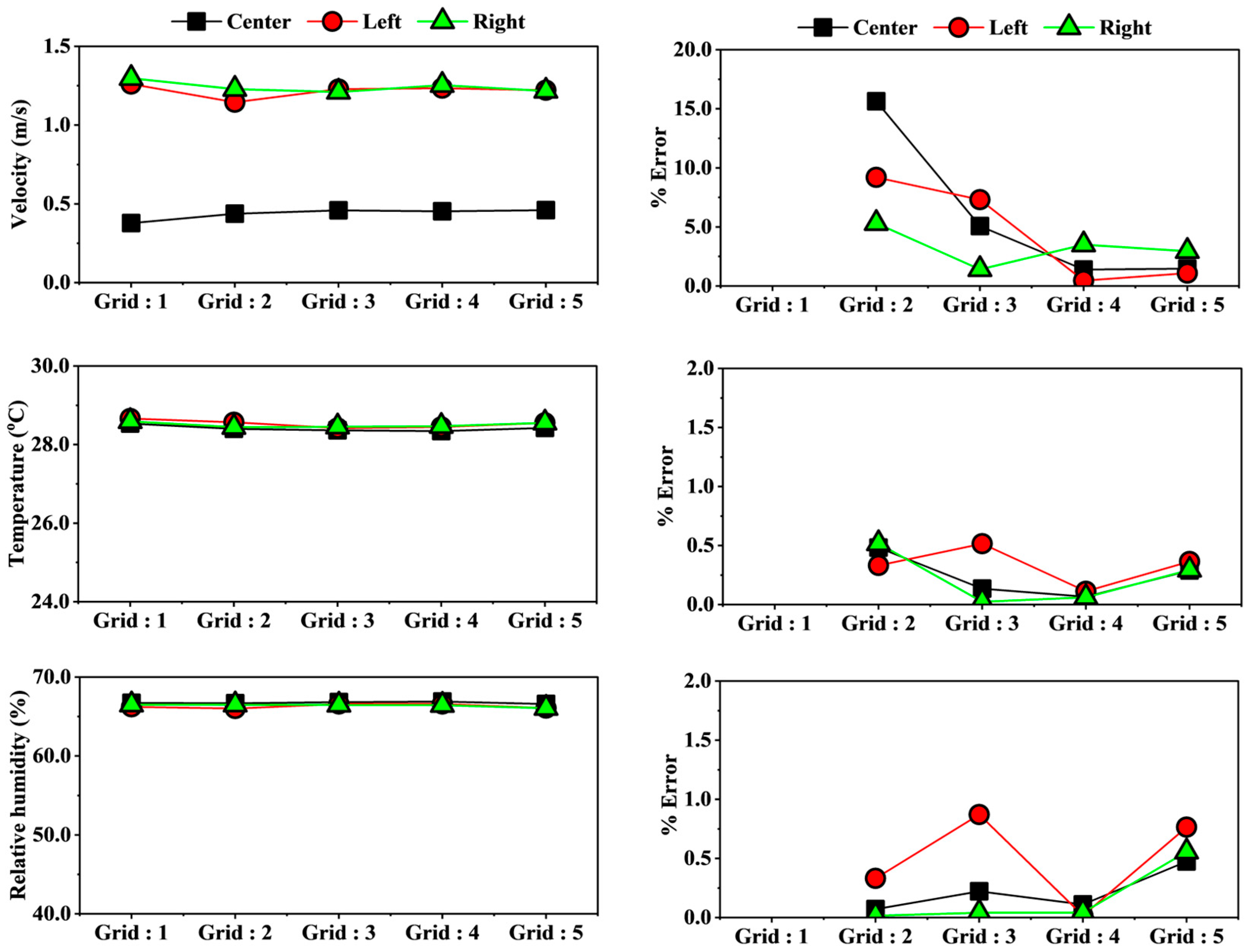
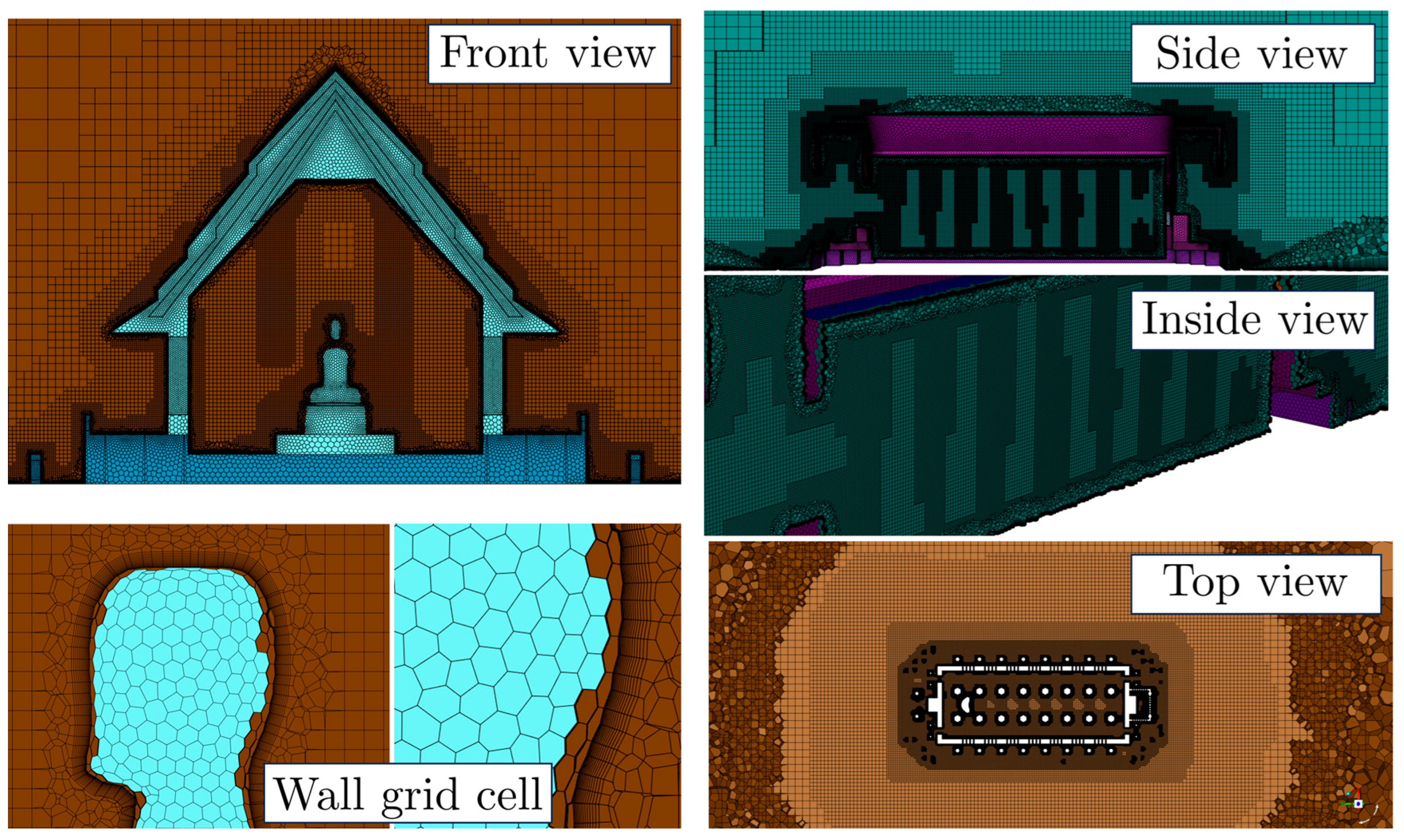
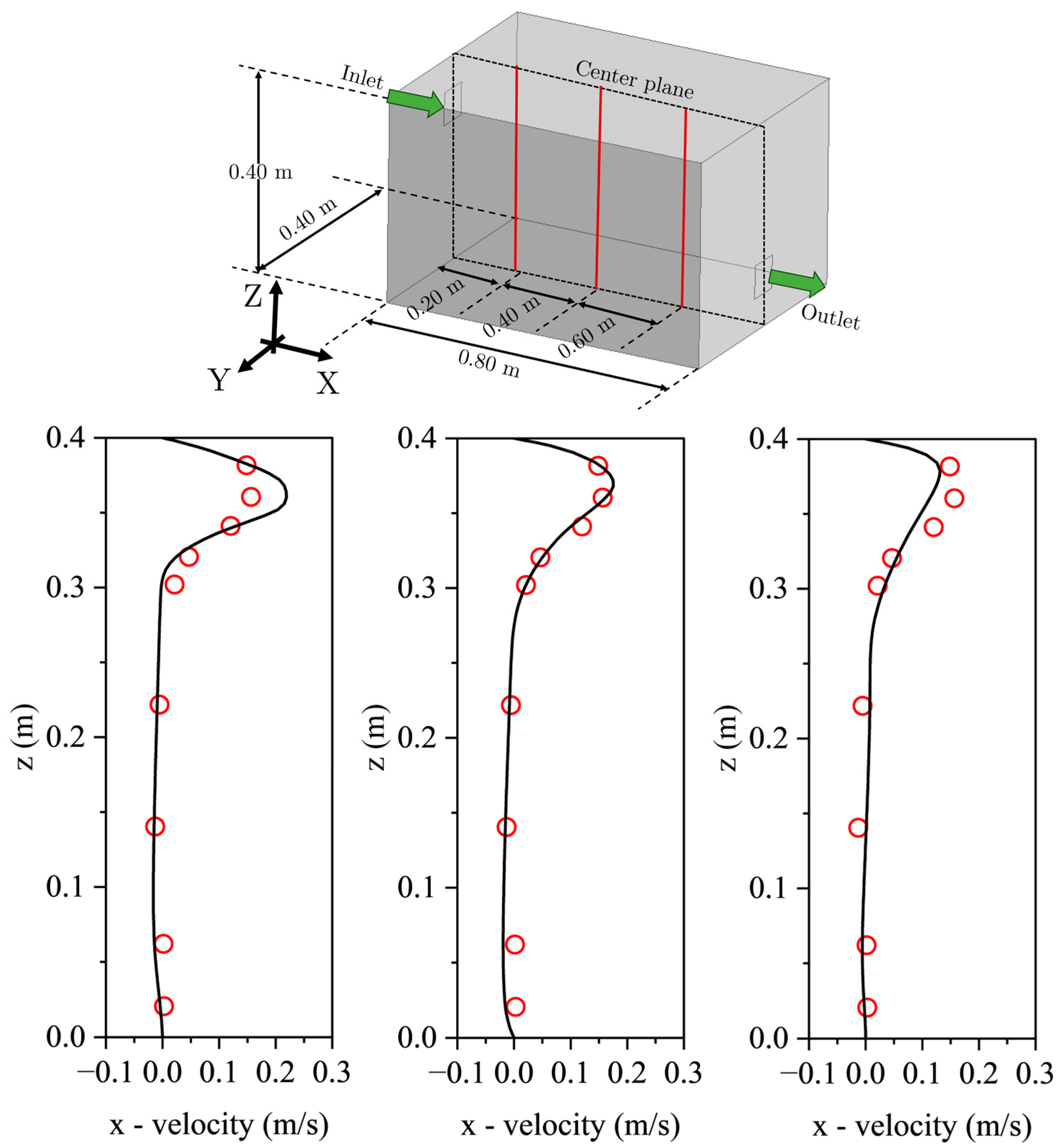
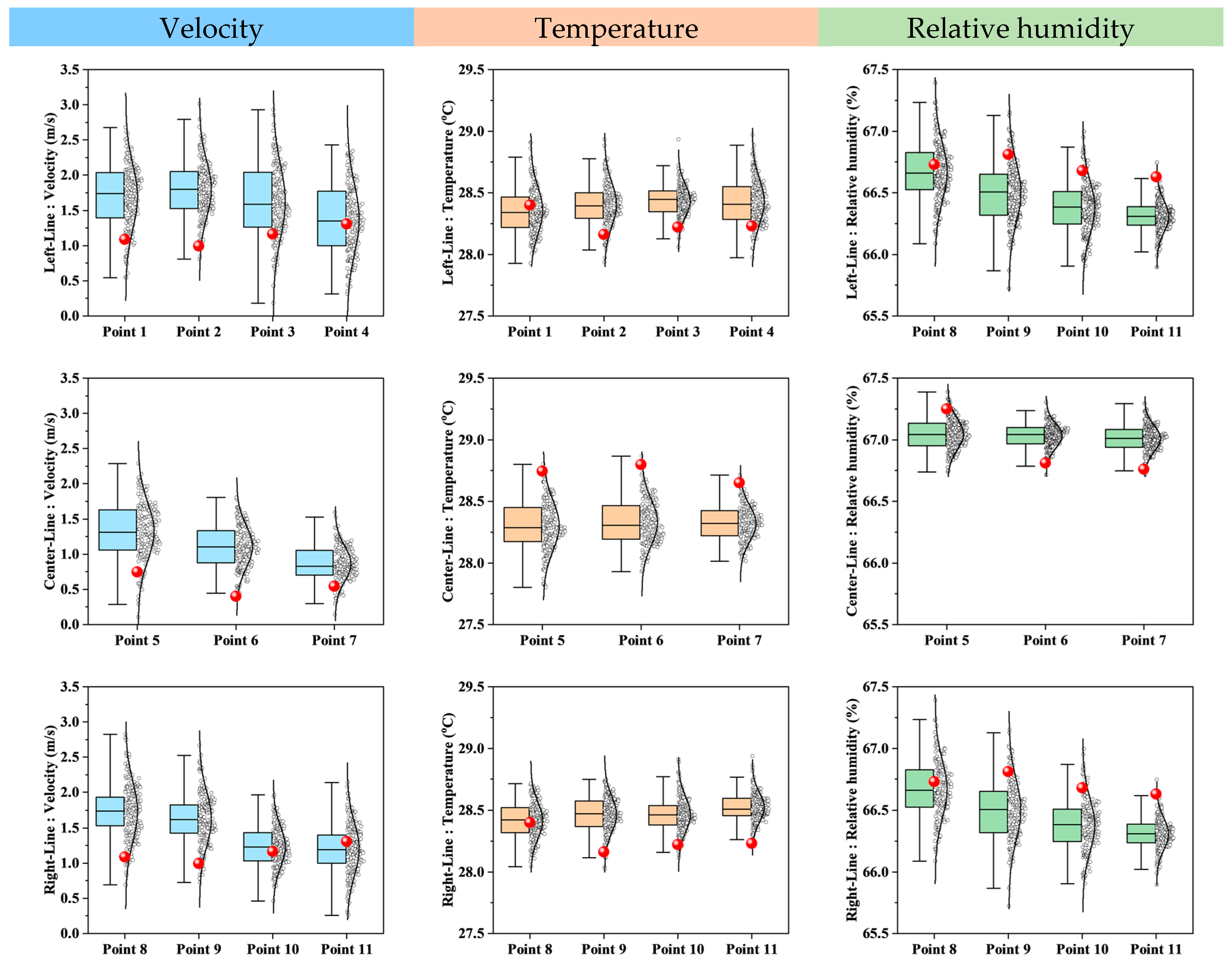
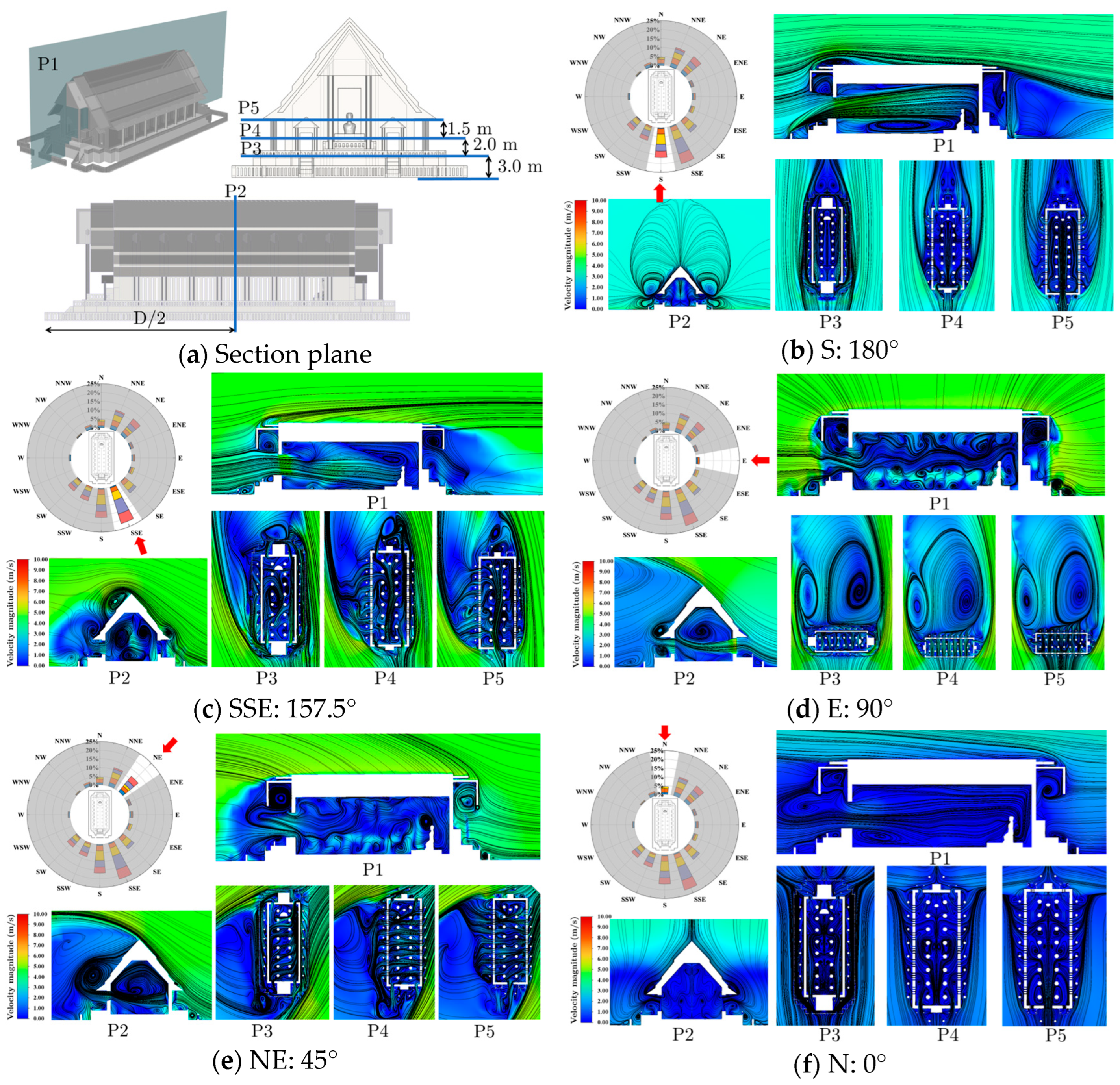


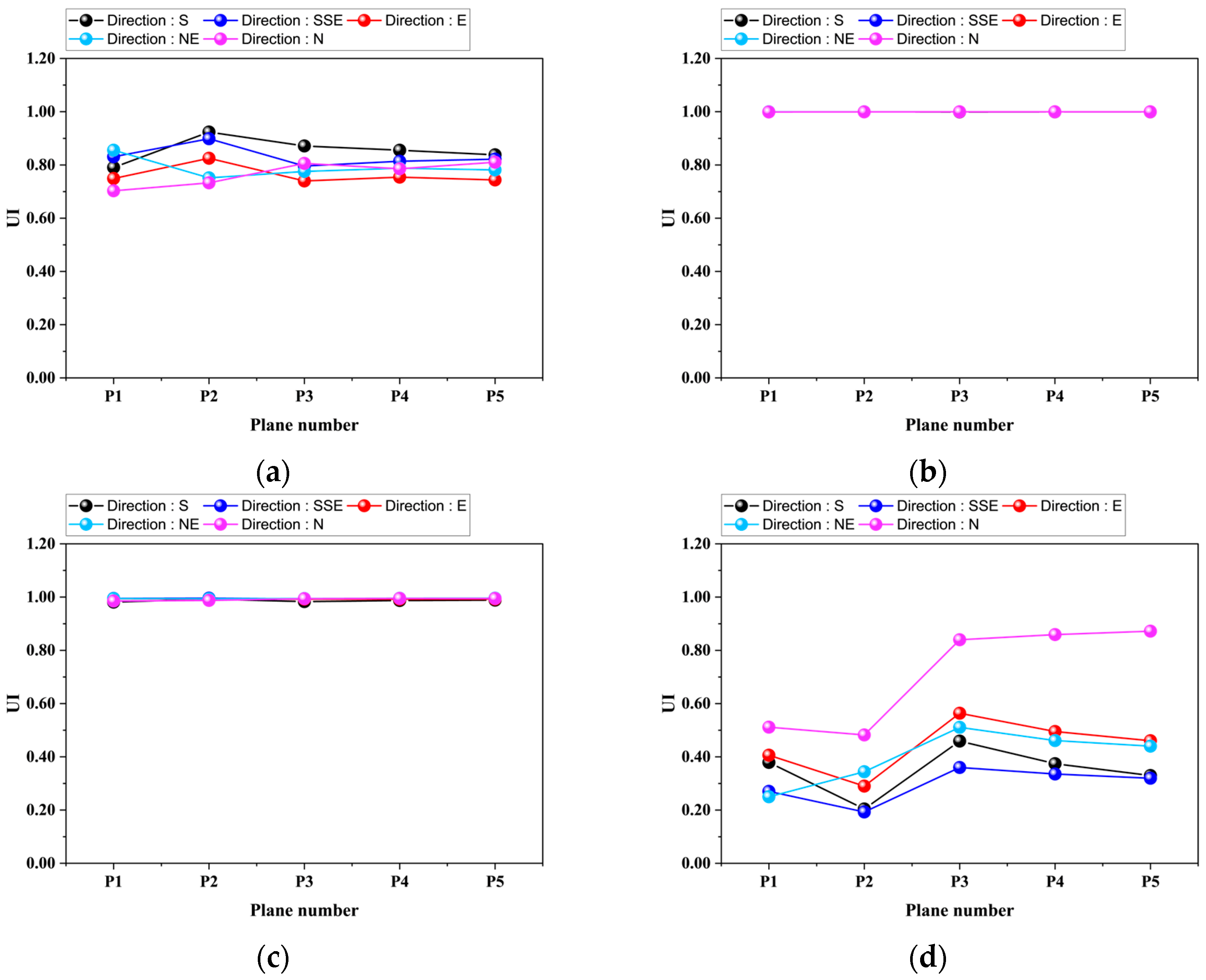
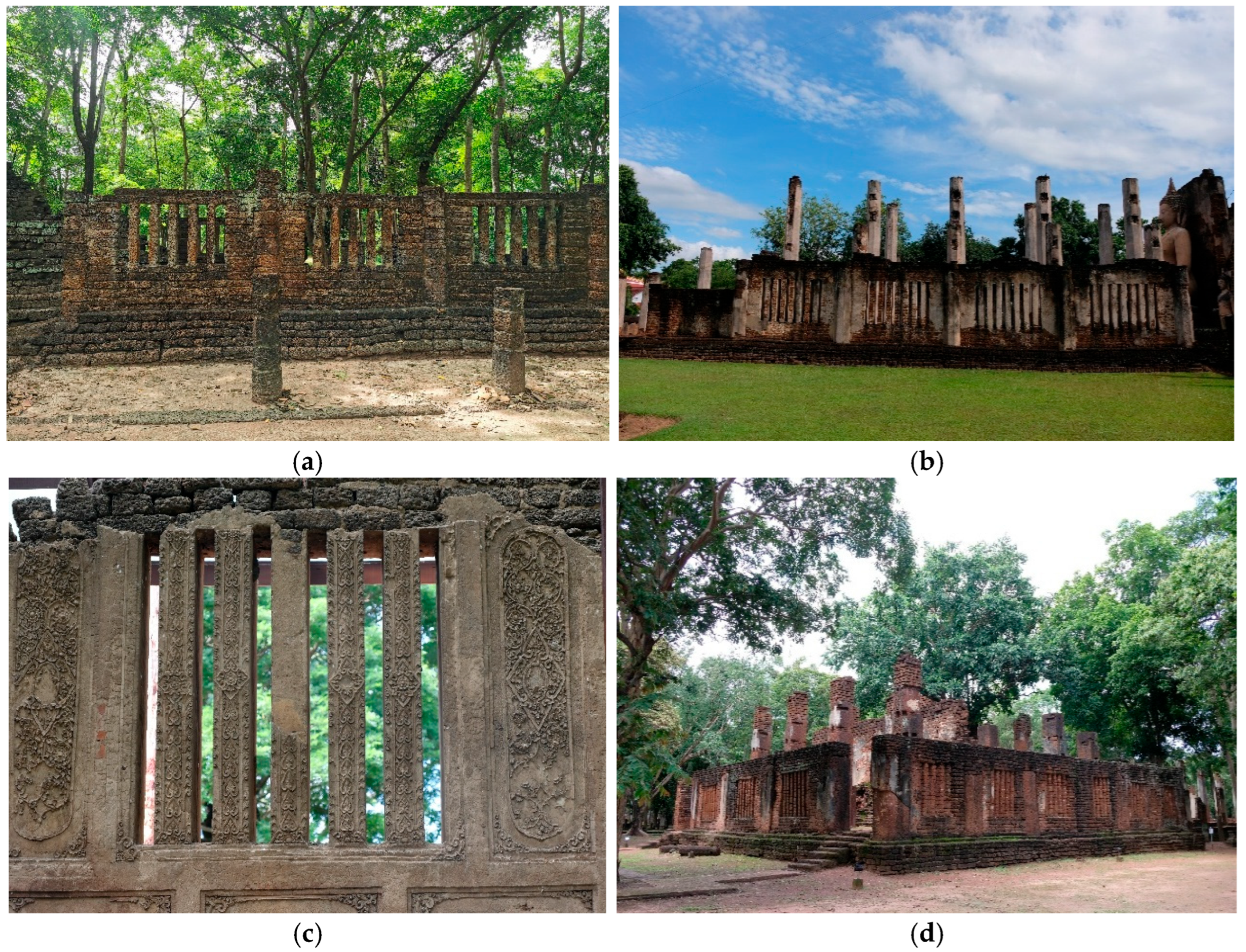


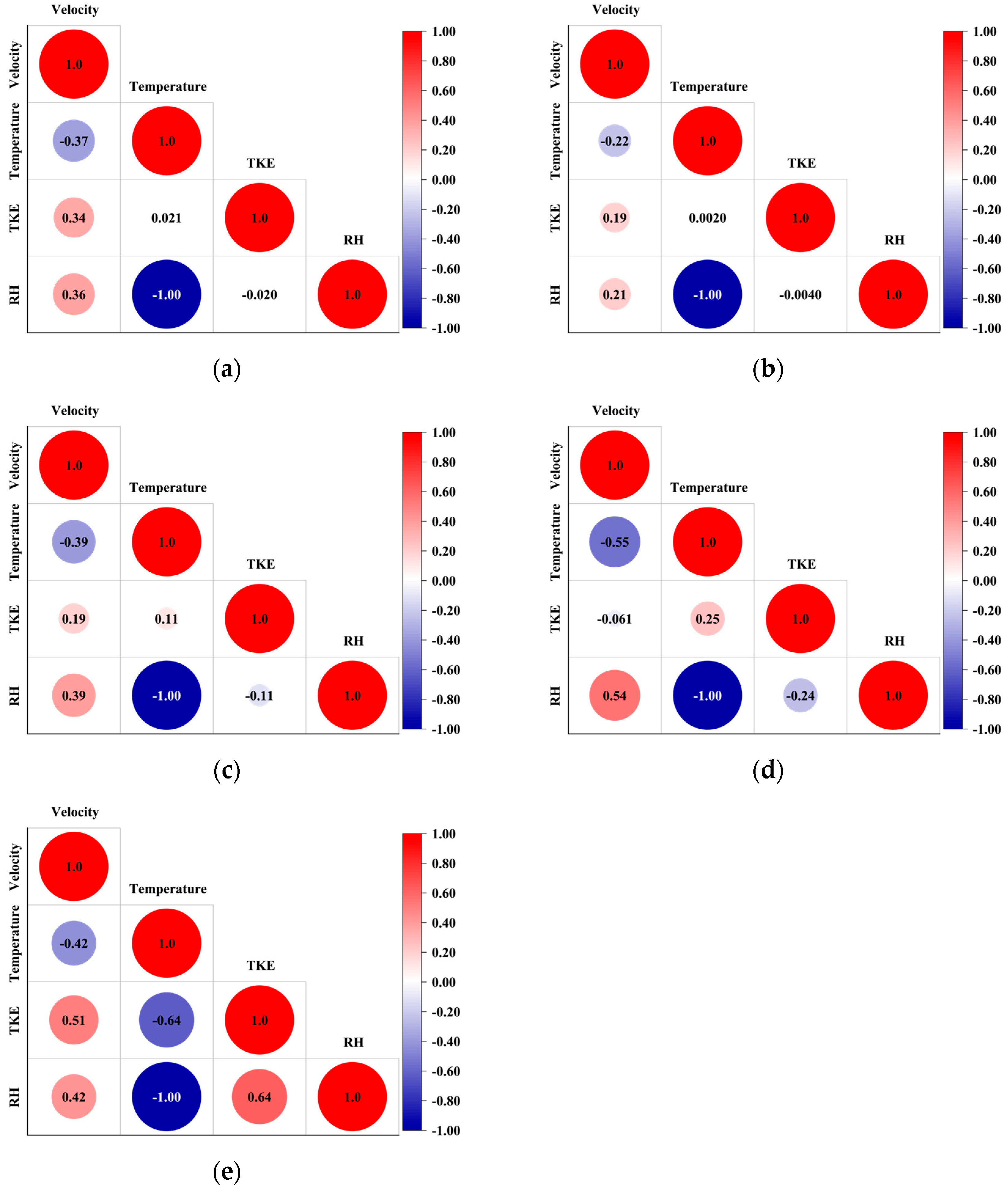
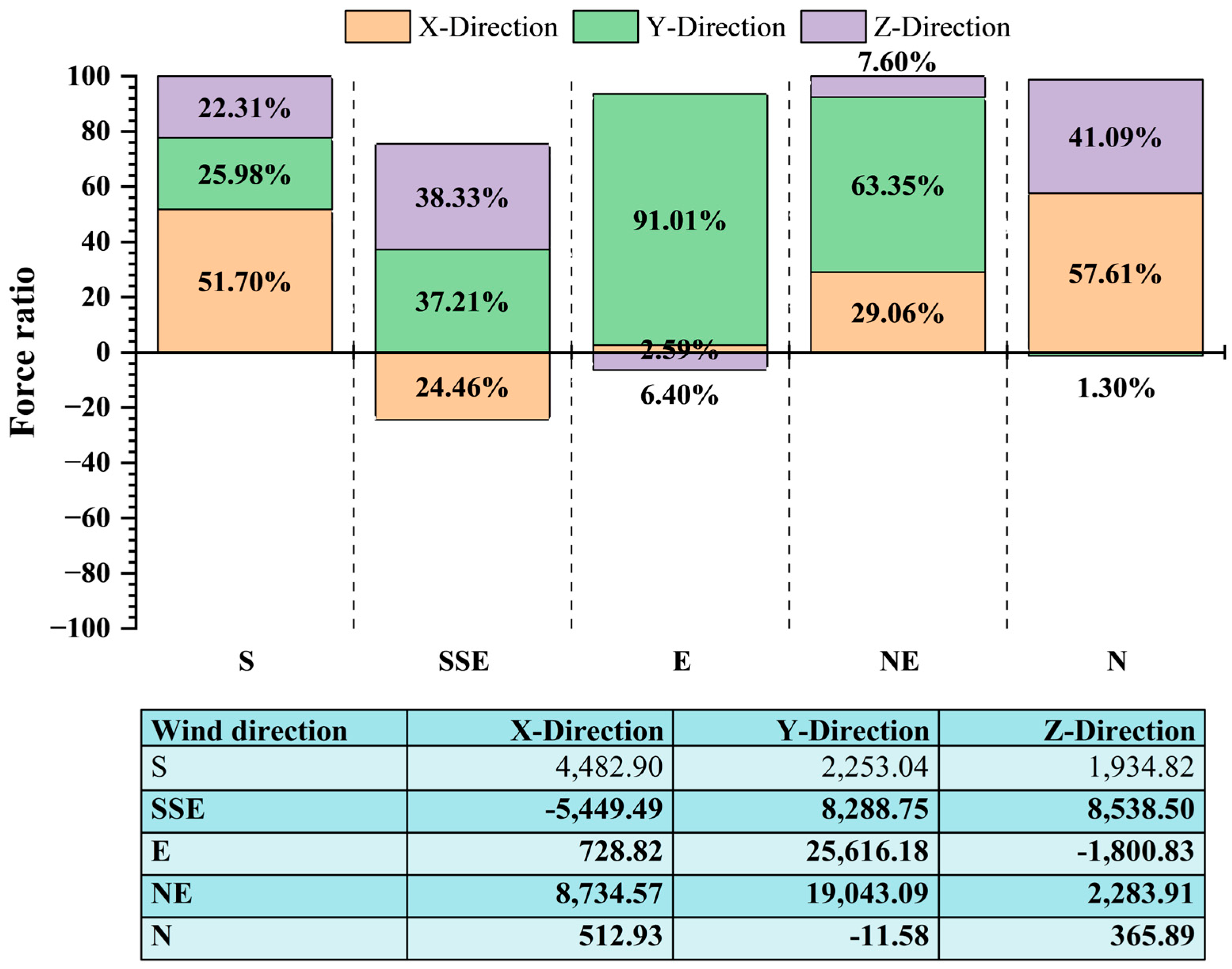
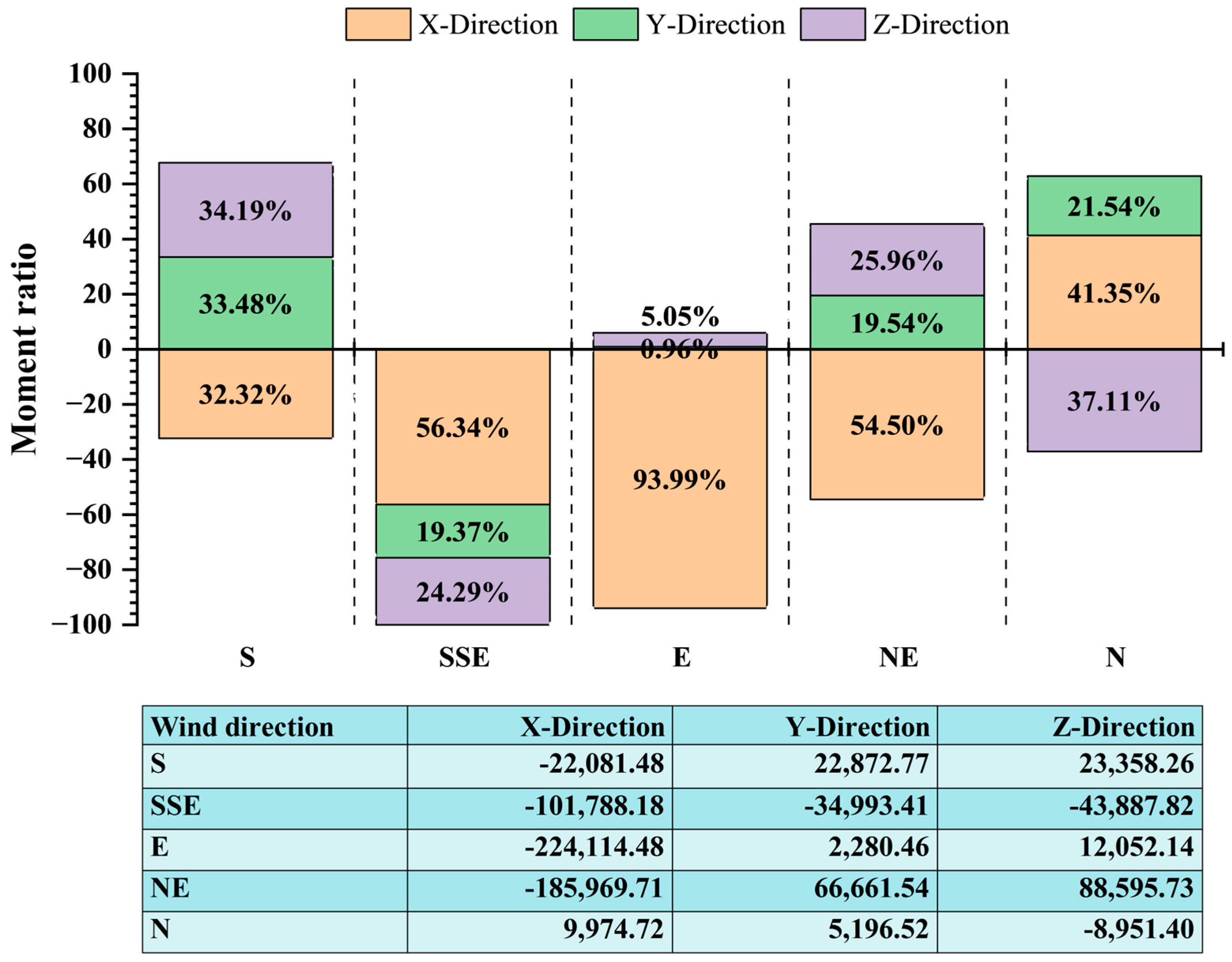
| Boundary Surface | Boundary Condition Type | Case 1 (Validation) | Case 2 | Case 3 |
|---|---|---|---|---|
| Inlet | Velocity inlet Temperature Relative humidity | U0 = 2.93 m/s T0 = 27.85 °C %RH = 66.0% | U0 = 3.50 m/s T0 = 27.85 °C %RH = 66.0% | U0 = 5.50 m/s T0 = 27.85 °C %RH = 66.0% |
| Outlet | Pressure outlet | |||
| Bottom wall | No-slip wall Heat flux | q = 35 w/m2 | q = 35 w/m2 | q = 35 w/m2 |
| Roof | Heat flux | q = 40 w/m2 | q = 40 w/m2 | q = 40 w/m2 |
| Property | Grid 1 | Grid 2 | Grid 3 | Grid 4 | Grid 5 |
|---|---|---|---|---|---|
| Total | 5,736,520 | 9,934,053 | 10,935,499 | 16,365,087 | 21,505,898 |
| Cartesian hex element | 1,408,485 24.55% | 726,235 7.31% | 838,697 7.67% | 5,507,841 33.66% | 5,442,178 25.31% |
| Polyhedral transition element | 1,164,269 20.30% | 2,569,734 25.87% | 2,831,350 25.89% | 4,714,679 28.81% | 3,409,531 15.85% |
| Poly prism element | 3,163,766 55.15% | 6,638,084 66.82% | 7,265,452 66.44% | 6,142,567 37.53% | 12,654,189 58.84% |
| Number of boundary layers | 5 | 10 | 10 | 10 | 15 |
| Average Y+ | 12 | <1 | <1 | <1 | <1 |
| Peak memory (Gb) | 24.92 | 39.32 | 42.57 | 59.84 | 84.92 |
| Solution Control | Method |
|---|---|
| Spatial discretization | |
| Pressure | Standard |
| Momentum | 2nd Order upwind |
| Turbulence kinetic energy | 2nd Order upwind |
| Specific dissipation rate | 2nd Order upwind |
| All species | 2nd Order upwind |
| Energy | 2nd Order upwind |
| Multigrid | |
| Flow | F-cycle |
| Turbulence kinetic energy | Flexible |
| Specific dissipation rate | Flexible |
| All species | Flexible |
| Energy | F-Cycle |
| Correlation | Correlation Level |
|---|---|
| −1.00 to −0.70 | Strong negative |
| −0.70 to −0.40 | Moderate negative |
| −0.40 to −0.10 | Weak negative |
| −0.10 to 0.10 | No correlation |
| 0.10 to 0.40 | Weak positive |
| 0.40 to 0.70 | Moderate positive |
| 0.70 to 1.00 | Strong positive |
Disclaimer/Publisher’s Note: The statements, opinions and data contained in all publications are solely those of the individual author(s) and contributor(s) and not of MDPI and/or the editor(s). MDPI and/or the editor(s) disclaim responsibility for any injury to people or property resulting from any ideas, methods, instructions or products referred to in the content. |
© 2025 by the authors. Licensee MDPI, Basel, Switzerland. This article is an open access article distributed under the terms and conditions of the Creative Commons Attribution (CC BY) license (https://creativecommons.org/licenses/by/4.0/).
Share and Cite
Kaewbumrung, M.; Plengsa-Ard, C.; Palasai, W. Sustainable Preservation of Historical Temples Through Ventilation Airflow Dynamics and Environmental Analysis Using Computational Fluid Dynamics. Appl. Sci. 2025, 15, 7466. https://doi.org/10.3390/app15137466
Kaewbumrung M, Plengsa-Ard C, Palasai W. Sustainable Preservation of Historical Temples Through Ventilation Airflow Dynamics and Environmental Analysis Using Computational Fluid Dynamics. Applied Sciences. 2025; 15(13):7466. https://doi.org/10.3390/app15137466
Chicago/Turabian StyleKaewbumrung, Mongkol, Chalermpol Plengsa-Ard, and Wasan Palasai. 2025. "Sustainable Preservation of Historical Temples Through Ventilation Airflow Dynamics and Environmental Analysis Using Computational Fluid Dynamics" Applied Sciences 15, no. 13: 7466. https://doi.org/10.3390/app15137466
APA StyleKaewbumrung, M., Plengsa-Ard, C., & Palasai, W. (2025). Sustainable Preservation of Historical Temples Through Ventilation Airflow Dynamics and Environmental Analysis Using Computational Fluid Dynamics. Applied Sciences, 15(13), 7466. https://doi.org/10.3390/app15137466






